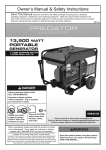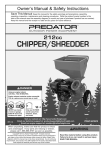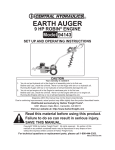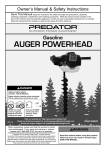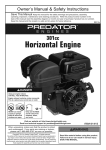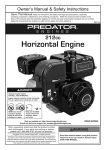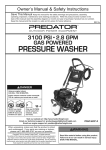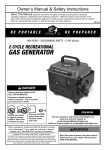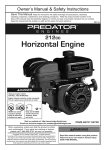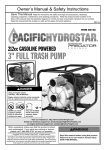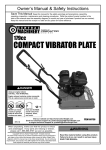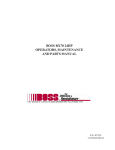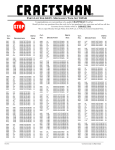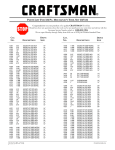Download Harbor Freight Tools (670cc) Product manual
Transcript
Owner’s Manual & Safety Instructions Save This Manual Keep this manual for the safety warnings and precautions, assembly, operating, inspection, maintenance and cleaning procedures. Write the product’s serial number in the back of the manual near the assembly diagram (or month and year of purchase if product has no number). Keep this manual and the receipt in a safe and dry place for future reference. REV 15e Using an engine indoors CAN KILL YOU IN MINUTES. Engine exhaust contains carbon monoxide. This is a poison you cannot see or smell. NEVER use inside a home or garage, EVEN IF doors and windows are open. Only use OUTSIDE and far away from windows, doors, and vents. Visit our website at: http://www.harborfreight.com Email our technical support at: [email protected] When unpacking, make sure that the product is intact and undamaged. If any parts are missing or broken, please call 1-888-866-5797 as soon as possible. Copyright© 2013 by Harbor Freight Tools®. All rights reserved. No portion of this manual or any artwork contained herein may be reproduced in any shape or form without the express written consent of Harbor Freight Tools. Diagrams within this manual may not be drawn proportionally. Due to continuing improvements, actual product may differ slightly from the product described herein. Tools required for assembly and service may not be included. Read this material before using this product. Failure to do so can result in serious injury. SAVE THIS MANUAL. Table of Contents Specifications.............................................. 2 Safety��������������������������������������������������������� 3 Setup........................................................... 6 Operationr��������������������������������������������������� 16 Maintenances���������������������������������������������� 20 Troubleshooting.......................................... 24 Warranties.................................................. 26 Parts Lists and Diagrams........................... 28 Specifications Displacement Engine Type Cooling System Fuel Type Engine Oil Type Capacity Sound Level at 3 feet Bore x Stroke Compression Ratio Rotation viewed from PTO (power takeoff - the output shaft) Spark Plugs Valve Clearance Speed Shaft 670cc Horizontal/Vertical Double Cylinder 4-stroke Forced air cooled 87+ octane stabilizer treated unleaded gasoline SAE 10W-30 above 32° F SAE 5W30 at 32° F or below 2 Quart 88 dB 78 mm x 70 mm 8.2:1 Counterclockwise Gap Intake Exhaust Idle NGK® BPR5ES Torch® F5RTC 0.7 - 0.8 mm 0.13 - 0.17 mm 0.18 - 0.22 mm 1800 RPM Shaft Ø1″ x 3.56″ Keyway 1/4″ End Tapped 3/8″ - 24 UNF Type The emissions control system for this Engine is warranted for standards set by the U.S. Environmental Protection Agency and by the California Air Resources Board (also known as CARB). For warranty information, refer to the last pages of this manual. Page 2 For technical questions, please call 1-888-866-5797. ITEM 61614 WARNING SYMBOLS AND DEFINITIONS This is the safety alert symbol. It is used to alert you to potential personal injury hazards. Obey all safety messages that follow this symbol to avoid possible injury or death. Safety Indicates a hazardous situation which, if not avoided, will result in death or serious injury. Indicates a hazardous situation which, if not avoided, could result in death or serious injury. Indicates a hazardous situation which, if not avoided, could result in minor or moderate injury. Addresses practices not related to personal injury. RPM HP Property or Statement Revolutions Per Minute Horsepower WARNING marking concerning Risk of Eye Injury. Wear ANSI-approved safety goggles with side shields. Read the manual before set-up and/or use. WARNING marking concerning Risk of Hearing Loss. Wear hearing protection. Symbol Property or Statement WARNING marking concerning Risk of Respiratory Injury. Operate engine OUTSIDE and far away from windows, doors, and vents. WARNING marking concerning Risk of Fire while handling fuel. Do not smoke while handling fuel. WARNING marking concerning Risk of Fire. Do not refuel while operating. Keep flammable objects away from engine. IMPORTANT SAFETY INSTRUCTIONS Operation Symbol Setup Symbol Definitions WARNING! Read all instructions. Failure to follow all instructions listed below may result in fire, serious injury and/or DEATH. The warnings and precautions discussed in this manual cannot cover all possible conditions and situations that may occur. It must be understood by the operator that common sense and caution are factors which cannot be built into this product, but must be supplied by the operator. ITEM 61614 For technical questions, please call 1-888-866-5797. Maintenance SAVE THESE INSTRUCTIONS Page 3 Set up Precautions Safety 1. Gasoline fuel and fumes are flammable, and potentially explosive. Use proper fuel storage and handling procedures. Do not store fuel or other flammable materials nearby. 4. Set up and use only on a flat, level, well‑ventilated surface. 2. Have multiple ABC class fire extinguishers nearby. 6. Use only lubricants and fuel recommended in the Specifications chart of this manual. 3. Operation of this equipment may create sparks that can start fires around dry vegetation. A spark arrestor may be required. The operator should contact local fire agencies for laws or regulations relating to fire prevention requirements. 5. Wear ANSI-approved safety goggles, heavy-duty work gloves, and dust mask/respirator during set up. 7. Fuel tank must be designed specifically for containing gasoline and must be mounted to a stable mounting frame. Some areas may have specific gasoline vapor containment requirements; comply with local, state, and federal laws. Operating Precautions CARBON MONOXIDE HAZARD Using an engine indoors CAN KILL YOU IN MINUTES. Engine exhaust contains carbon monoxide. This is a poison you cannot see or smell. 1. 9. Industrial applications must follow OSHA requirements. Setup 10. Do not leave the engine unattended when it is running. Turn off the engine (and remove safety keys, if available) before leaving the work area. 11. The engine can produce high noise levels. Prolonged exposure to noise levels above 85 dBA is hazardous to hearing. Wear ear protection when operating the engine or when working nearby while it is operating. 12. Wear ANSI-approved safety glasses and hearing protection during use. NEVER use inside a home or garage, EVEN IF doors and windows are open. Operation Only use OUTSIDE and far away from windows, doors, and vents. 2. Keep children away from the equipment, especially while it is operating. 13. People with pacemakers should consult their physician(s) before use. Electromagnetic fields in close proximity to a heart pacemaker could cause pacemaker interference or pacemaker failure. Caution is necessary when near the engine’s magneto or recoil starter. 14. Use only accessories that are recommended by Harbor Freight Tools for your model. Accessories that may be suitable for one piece of equipment may become hazardous when used on another piece of equipment. Maintenance 3. Keep all spectators at least six feet from the Engine during operation. 15. Do not operate in explosive atmospheres, such as in the presence of flammable liquids, gases, or dust. Gasoline-powered engines may ignite the dust or fumes. 4. Fire Hazard! Do not fill fuel tank while engine is running. Do not operate if gasoline has been spilled. Clean spilled gasoline before starting engine. Do not operate near pilot light or open flame. 16. Stay alert, watch what you are doing and use common sense when operating this engine. Do not use while tired or under the influence of drugs, alcohol or medication. 5. Do not touch engine during use. Let engine cool down after use. 17. Dress properly. Do not wear loose clothing or jewelry. Keep hair, clothing and gloves away from moving parts. Loose clothes, jewelry or long hair can be caught in moving parts. 6. Never store fuel or other flammable materials near the engine. 7. Only use a suitable means of transport and lifting devices with sufficient weight bearing capacity when transporting the engine. 8. Secure the engine on transport vehicles to prevent it from rolling, slipping, and tilting. Page 4 18. Parts, especially exhaust system components, get very hot during use. Stay clear of hot parts. 19. Do not cover the engine during operation. 20. Keep the engine and surrounding area clean at all times. For technical questions, please call 1-888-866-5797. ITEM 61614 22. Do not operate the equipment with known leaks in the engine’s fuel system. 23. WARNING: This product contains or, when used, produces a chemical known to the State of California to cause cancer and birth defects or other reproductive harm. (California Health & Safety Code § 25249.5, et seq.) 24. When spills of fuel or oil occur, they must be cleaned up immediately. Dispose of fluids and cleaning materials as per any local, state, or federal codes and regulations. Store oil rags in a bottom-ventilated, covered, metal container. 25. Keep hands and feet away from moving parts. Do not reach over or across equipment while operating. 26. Before use, check for misalignment or binding of moving parts, breakage of parts, and any other condition that may affect the equipment’s operation. If damaged, have the equipment serviced before using. Many accidents are caused by poorly maintained equipment. Safety 21. Use the equipment, accessories, etc., in accordance with these instructions and in the manner intended for the particular type of equipment, taking into account the working conditions and the work to be performed. Use of the equipment for operations different from those intended could result in a hazardous situation. 27. Use the correct equipment for the application. Do not modify the equipment and do not use the equipment for a purpose for which it is not intended. a. Turn the engine switch to its “OFF” position. b. Allow the engine to completely cool. c. Then, remove the spark plug caps from the spark plugs. 2. Keep all safety guards in place and in proper working order. Safety guards include muffler, air cleaner, mechanical guards, and heat shields, among other guards. 3. Do not alter or adjust any part of the equipment or its engine that is sealed by the manufacturer or distributor. Only a qualified service technician may adjust parts that may increase or decrease governed engine speed. 4. Wear ANSI-approved safety goggles, heavy‑duty work gloves, and dust mask/respirator during service. 5. Maintain labels and nameplates on the equipment. These carry important information. If unreadable or missing, contact Harbor Freight Tools for a replacement. 6. Have the equipment serviced by a qualified repair person using only identical replacement parts. This will ensure that the safety of the equipment is maintained. Do not attempt any service or maintenance procedures not explained in this manual or any procedures that you are uncertain about your ability to perform safely or correctly. 7. Store equipment out of the reach of children. 8. Follow scheduled engine and equipment maintenance. Refueling: 1. Do not smoke, or allow sparks, flames, or other sources of ignition around the equipment, especially when refuelling. 2. Do not refill the fuel tank while the engine is running or hot. 3. Do not fill fuel tank to the top. Leave a little room for the fuel to expand as needed. 4. Refuel in a well-ventilated area only. 5. Wipe up any spilled fuel and allow excess to evaporate before starting engine. To prevent FIRE, do not start the engine while the smell of fuel hangs in the air. For technical questions, please call 1-888-866-5797. Maintenance SAVE THESE INSTRUCTIONS. ITEM 61614 Operation 1. Before service, maintenance, or cleaning: Setup Service Precautions Page 5 Set Up Read the ENTIRE IMPORTANT SAFETY INFORMATION section at the beginning of this manual including all text under subheadings therein before set up or use of this product. Safety TO PREVENT SERIOUS INJURY: Operate only with proper spark arrestor installed. Operation of this equipment may create sparks that can start fires around dry vegetation. A spark arrestor may be required. The operator should contact local fire agencies for laws or regulations relating to fire prevention requirements. WARNING! DO NOT INSTALL THIS ENGINE ON A VEHICLE. WARNING! INSTALL THIS ENGINE ACCORDING TO EQUIPMENT INSTRUCTIONS BEFORE USE. WARNING! If you do not connect a battery to the positive battery cable, wrap its terminal securely with electrical tape (sold separately). Setup Operation Maintenance Page 6 For technical questions, please call 1-888-866-5797. ITEM 61614 Components and Controls Muffler Safety Oil Fill Plug Lifting Bracket Setup Spark Plug (1 of 2) Dipstick Starter Operation Air Cleaner Lifting Bracket Choke Spark Plug (2 of 2) Throttle Radiator Circuit Breaker ITEM 61614 For technical questions, please call 1-888-866-5797. Page 7 Maintenance Switch High Altitude Operation Above 3000 feet WARNING! TO PREVENT SERIOUS INJURY FROM FIRE: Follow instructions in a well-ventilated area away from ignition sources. If the engine is hot from use, shut the engine off and wait for it to cool before proceeding. Do not smoke. Safety NOTICE: Warranty void if necessary adjustments are not made for high altitude use. At high altitudes, the engine’s carburetor, governor (if so equipped), and any other parts that control the fuel-air ratio will need to be adjusted by a qualified mechanic to allow efficient high-altitude use and to prevent damage to the engine and any other devices used with this product. The fuel system on this engine may be influenced by operation at higher altitudes. Proper operation can be ensured by installing an altitude kit at altitudes higher than 3000 ft. above sea level. At elevations above 8000 ft, the engine may experience decreased performance, even with the proper main jet. Operating this engine without the proper altitude kit installed may increase the engine’s emissions and decrease fuel economy and performance. The kit should be installed by a qualified mechanic. High Altitude Kit Parts List - A Setup Part A1 A2 A3 Description Left Main Jet 3000-6000 ft. Right Main Jet 3000-6000 ft. Left Main Jet 6000-8000 ft. Qty 1 1 1 Part Description A4 Right Main Jet 6000-8000 ft. 137d Outer Bowl O-ring (replacement) 137e Inner Bowl O-ring (replacement) Qty 1 2 2 Disassembly 1. Turn off the engine. 2. Close the fuel valve, if equipped. If no fuel valve is equipped, then clamp the fuel hose closed right before the filter. Be careful to avoid damaging the fuel hose. 4. Remove the Air Cleaner Front Cover (101), pulling it up then out. See Figure B. Air Cleaner Front Cover (101) 3. Remove the Air Cleaner Top Knob (142a) and the two Air Cleaner Front Knobs (102). See Figure A. Air Cleaner Top Knob (142a) Operation Air Cleaner Front Knob (102) Figure B: Remove Front Cover Maintenance Figure A: Remove Knobs Page 8 For technical questions, please call 1-888-866-5797. ITEM 61614 Air Cleaner Top Cover (142b) 9. Remove the four Shroud Nuts (99) and the two Flange Shoulder Bolts (112) from the Shroud (100). The Flange Shoulder Bolt on the right holds the Lifting Bracket (111) in place. See Figure E. Flange Shoulder Bolt (112) Flange Shoulder Bolt (112) behind Lifting Bracket Air Cleaner Spacer (142c) Safety 5. Remove the Air Cleaner Top Cover (142b) and internal Air Cleaner components (Spacer, Foam and Paper Filters (142c-142e)). See Figure C. Foam Air Filter (142d) Setup Paper Air Filter (142e) Shroud Nuts (99) Figure C: Remove Air Cleaner Top Cover and components 6. Remove the two Intake Cover Bolts (143) and the two Air Cleaner Base Bolts (146). See Figure D. Note: Air Cleaner Front Cover is still shown, although it should have been removed in step 4. Shroud (100) Figure E: Remove Shroud 10. Remove the Shroud. Intake Cover Bolts (143) Operation 7. Detach the top of the Fuel Filter Clip (147) from the Air Cleaner Base (142g). Air Cleaner Base Bolts (146) Fuel Filter Clip (147) Maintenance Air Cleaner Base (142g) Figure D: Remove Bolts and Clip from Air Cleaner Base 8. Remove the Air Cleaner Base. ITEM 61614 For technical questions, please call 1-888-866-5797. Page 9 11. WARNING! TO PREVENT SERIOUS INJURY FROM FIRE, BEFORE CONTINUING: a. Make sure that the work area is well‑ventilated and that there are no ignition sources. b. Have multiple class ABC fire extinguishers available. c. Double-check that fuel hose leading from fuel tank to Fuel Filter is clamped or fuel valve is closed. Safety d. Use a safe, proper means to clean up all fuel spills immediately. 12. Squeeze the Spring Clamp (140) and slide it back. Detach the Fuel Hose (141) from the port at the top of the Carburetor. See Figure F. Spring Clamp (140) 15. Disconnect the Throttle Rod Spring from the Throttle Rod Clip. 16. Squeeze the Spring Wire Clamp (32) and slide it back. Detach the Breather Hose (33) from the right side of the Carburetor. See Figure I. Spring Wire Clamp (32) Fuel Hose (141) fuel port Breather Hose (33) Setup Figure F: Detach Fuel Hose 13. Locate the Throttle Rod (174) connection on the left side of the carburetor. See Figure G. Throttle Rod (174) Operation Throttle Rod Spring (175) Figure I: Detach Breather Hose 17. Locate the Choke Rod (177) connection on the right side of the carburetor. See Figure J. Choke Rod Clip (176) Throttle Rod Clip (139) Choke Rod (177) Figure G: Disconnect Throttle Rod Maintenance 14. A: Swing the black Throttle Rod Clip (139) down to release the Throttle Rod. See Figure H. B: Pull the Throttle Rod out of the Clip. Figure J: Disconnect Choke Rod 18. Swing the black Choke Rod Clip (176) aside to release the Choke Rod. Disconnect the Choke Rod. B A Figure H: Throttle Rod Clip Page 10 For technical questions, please call 1-888-866-5797. ITEM 61614 20. Underneath where the Fuel Pump Bracket was, the Solenoid Valve (138) is connected. Note the location of the green wire and green dot on the connector. Unplug the connector. See Figure L. Carburetor Intake Elbow (131) Fuel Pump Bracket (40) Bolt (132) Bolt (133) Bolt (132) Safety 19. At the front of the Carburetor, remove the Bolt (38) holding the Fuel Pump Bracket (40) in place. See Figure K. Bolt (38) Figure K: Remove Fuel Pump Bracket Solenoid wire connector Figure L: Disconnect Solenoid Valve wire connector Setup Note location of dots here. 21. Remove Bolt (133) and two Bolts (132) from the Carburetor Intake Elbow (131). See Figure L. Maintenance Operation 22. Remove the Carburetor assembly from the engine. Keep it upright, it may contain fuel. ITEM 61614 For technical questions, please call 1-888-866-5797. Page 11 23. Hold the fuel drain port over a bowl, and open the Carburetor Drain Plug (137a) to allow fuel to drain out of that port. Once the carburetor is empty, close the Carburetor Drain Plug. See Figure M. 26. Use a carburetor screwdriver (sold separately) to remove the Left Main Jet and replace it with the proper replacement Left Main Jet (A1 or A3) for the altitude. See Figure O. Safety 27. Use a carburetor screwdriver to remove the Right Main Jet and replace it with the replacement Right Main Jet (A2 or A4) for the same altitude as the Left Main Jet. See Figure O. fuel drain port Carburetor Drain Plug (137a) Right Main Jet (A2/A4) Left Main Jet (A1/A3) Figure M: Carburetor Drain 24. Turn the Carburetor assembly over. Setup 25. Remove the four Carburetor Bowl Bolts (137b) and remove the Carburetor Bowl (137c). See Figure N. Carburetor Bowl Bolt (137b) Carburetor Bowl Bolt (137b) Operation Note: Since carburetor is upside-down, left and right sides are reversed. Figure O: Main Jets Carburetor Bowl (137c) Carburetor Bowl Bolt (137b) Carburetor Bowl Bolt (137b) Figure N: Carburetor Bowl Bolts Maintenance Page 12 For technical questions, please call 1-888-866-5797. ITEM 61614 Reassembly 1. Replace the Outer and Inner Bowl O-rings (137d, 137e) with the replacements from the altitude kit. Do not reuse existing O-rings. 5. Attach the Choke Rod on the right side of the Carburetor, and secure it with its Clip. [#17,18] 6. Attach the Breather Hose to the Carburetor, and secure it with its Clamp. [#16] 7. Attach the Throttle Rod Spring to the Throttle Rod Clip on the left side of the Carburetor. [#15] Inner Bowl O-ring 8. Insert the Throttle Rod on the left side of the Carburetor, and secure it with its Clip. [#14] Safety Note: Reassembly step references shown in brackets. 9. Attach the Fuel Hose to the port at the top of the Carburetor and attach it using its Clamp. [#12] Outer Bowl O-ring 10. Install Shroud using four Shroud Bolts and two Flange Shoulder Bolts. [#9,10] Include the Lifting Bracket in place on the right Flange Shoulder Bolt. Carburetor Bowl Figure P: Replace Bowl O-rings 2. Assemble the Carburetor Bowl using four Carburetor Bowl Bolts. [#25] Assemble Carburetor Intake Elbow to Intake using Bolts. [#21] 3. Attach Solenoid Valve connector, line up green wire with the green dot on the connector. [#20] 13. Replace the Air Cleaner Front Cover. [#4] 14. Use the Air Cleaner Top Knob and Air Cleaner Front Knobs to secure the Covers in place. [#3] 15. Once all connections are secure, open fuel valve/unclamp fuel hose. 16. Wipe up any spilled fuel and allow excess to evaporate before starting engine. To prevent FIRE, do not start the engine while the smell of fuel hangs in the air. Maintenance Operation 4. Attach Fuel Pump Bracket to front of intake using Bolt. Gently lift the Bracket after assembly to ensure proper alignment. [#19] 12. Place the Paper Air Filter, Foam Air Filter, Air Cleaner Spacer, and Air Cleaner Top Cover into place on the Air Cleaner Base. [#5] Setup 11. Install Air Cleaner Base using two Air Cleaner Base Bolts. Connect Fuel Filter Clip under left side of Air Cleaner Base. Install the Intake Cover and Intake Screen using the Intake Cover Bolts. [#6-8] ITEM 61614 For technical questions, please call 1-888-866-5797. Page 13 Battery Setup Instructions Safety 1. Place a fully charged, lead-acid 12 volt, 36 Ah battery (not included) in a stable, flat location near the engine. solenoid on Starter (164) 2. Only use cables sized to match their length according to . red wire to positive battery cable (lower gauge numbers mean thicker cables) Cable Gauge Maximum Cable Length 6 4 2 5′ 7′ 12′ connect negative battery cable to a mounting bolt Table A: Minimum Cable Diameters Setup 3. Attach the positive cable from the positive battery terminal to the outer terminal on the Starter’s (164) solenoid, see Figure Q and Figure R. Connect cable securely to prevent disconnection and short circuits. 4. Attach the negative cable to the negative battery terminal. Figure Q: Battery Cable Connections Connect Cable from Positive Battery Terminal to this Starter Terminal 5. Connect the negative cable securely to one of the engine mounting bolts, as shown in Figure Q. Connect cable securely to prevent disconnection and short circuits. Operation 6. Coat the terminals and cable ends with a corrosion-preventive coating. Figure R: Connect Positive to this Terminal Maintenance Page 14 For technical questions, please call 1-888-866-5797. ITEM 61614 Fuel Tank Setup Instructions 3. Connect a fuel hose from the fuel tank to the exposed port of the Fuel Filter, and secure it in place with a hose clamp. See Figure S. fuel hose connection Setup 2. WARNING! Fuel tank (not included) must be designed specifically for containing gasoline and must be mounted to a stable mounting frame. Some areas may have specific gasoline vapor containment requirements; comply with local, state, and federal laws. Safety 1. If possible, incorporate a fuel shutoff valve on the fuel hose (neither included). Maintenance Operation Figure S: Fuel Hose Connector ITEM 61614 For technical questions, please call 1-888-866-5797. Page 15 Operation Read the ENTIRE IMPORTANT SAFETY INFORMATION section at the beginning of this manual including all text under subheadings therein before set up or use of this product. Safety Pre-Start Checks Inspect engine and equipment looking for damaged, loose, and missing parts before set up and starting. If any problems are found, do not use equipment until fixed properly. Checking and Filling Engine Oil Setup NOTICE: Your Warranty is VOID if the engine’s crankcase is not properly filled with oil before each use. Before each use, check the oil level. Do not run the engine with low or no engine oil. Running the engine with no or low engine oil WILL permanently damage the engine. Oil Fill Plug 1. Make sure the engine is stopped and is level. 2. Close the Fuel Valve, if equipped. 3. Clean the top of the Dipstick and the area around it. Pull the Dipstick out, and wipe it off with a clean, lint free rag. Dipstick 4. Reinsert the Dipstick and remove it to check the oil level. The oil level should be up to the upper mark on the dipstick. Operation 5. If the oil level is at or below the low mark, remove the Oil Fill Plug and add the appropriate type of oil until the oil level is at the proper level. SAE 10W‑30 oil is recommended for general use. (Table B: SAE Viscosity Grade on page 21 in the Maintenance section shows other viscosities to use in different average temperatures.) Replace the Oil Fill Plug. 6. Insert the Dipstick back into the housing. Figure T: Oil Fill and Dipstick NOTICE: Do not run the engine with too little oil. The engine will be permanently damaged. Maintenance Page 16 For technical questions, please call 1-888-866-5797. ITEM 61614 Checking and Filling Fuel 1. Clean the Fuel Cap and the area around it. 2. Unscrew and remove the Fuel Cap. 3. Remove the Strainer and remove any dirt and debris. Then replace the Strainer. 4. If needed, fill the Fuel Tank to about 1 inch under the fill neck of the Fuel Tank with 87 octane or higher unleaded gasoline that has been treated with a fuel stabilizer additive. Follow fuel stabilizer manufacturer’s recommendations for use. 5. Then replace the Fuel Cap. 6. Wipe up any spilled fuel and allow excess to evaporate before starting engine. To prevent FIRE, do not start the engine while the smell of fuel hangs in the air. Maintenance Operation Setup Note: Do not use gasoline containing more than 10% ethanol (E10). Do not use E85 ethanol. Add fuel stabilizer to the gasoline or the Warranty is VOID. Note: Do not use gasoline that has been stored in a metal fuel container or a dirty fuel container. It can cause particles to enter the carburetor, affecting engine performance and/or causing damage. Safety WARNING! TO PREVENT SERIOUS INJURY FROM FIRE: Fill the fuel tank in a well-ventilated area away from ignition sources. If the engine is hot from use, shut the engine off and wait for it to cool before adding fuel. Do not smoke. ITEM 61614 For technical questions, please call 1-888-866-5797. Page 17 Starting the Engine Safety Before starting the engine: a. Follow the Set Up Instructions in this manual to prepare the engine. b. Follow the Set Up Instructions in the equipment manual to prepare the equipment. c. Inspect the equipment and engine. d. Fill the engine with the proper amount and type of both unleaded gasoline and oil. e. Read the Equipment Operation section in the equipment manual. 1. To start a cold engine, pull the Choke Knob out to the START position. To restart a warm engine, push the Choke in to the RUN position. 1 Setup 2. Open the Fuel Valve, if equipped. Operation 3. Slide the Throttle or Speed Control Lever to 1/3 away from the SLOW position (the “turtle”). Note: Some tools have a Speed Control Lever located elsewhere on the tool which functions the same as the Throttle. Use the Speed Control Lever in place of the Throttle when the tool is so equipped. 3 Maintenance ON 4. Insert the Key and turn it to START until the engine starts, no more than a few seconds. Release the Key when the engine starts. Page 18 OFF START 4 For technical questions, please call 1-888-866-5797. ITEM 61614 5. Allow the Engine to run for several seconds. Then, if the Choke Knob is in the pulled‑out START position, push the Choke Knob in very slowly to its RUN position. Safety 5 Note: Moving the Choke Knob too fast could stall the engine. IMPORTANT: Allow the engine to run at no load for five minutes after each start‑up so that the engine can stabilize. 6. Adjust the Throttle as needed. Setup Break-in Period: a. Breaking-in the engine will help to ensure proper equipment and engine operation. b. The operational break-in period will last about 3 hours of use. During this period: • Do not apply a heavy load to the equipment. • Do not operate the engine at its maximum speed. c. The maintenance break-in period will last about 20 hours of use. • Change the engine oil after this period. Under normal operating conditions subsequent maintenance follows the schedule explained in the Maintenance section. 1. To stop the engine in an emergency, turn the Key to OFF. Operation Stopping the Engine ON OFF START 2. Under normal conditions, use the following procedure: Maintenance a. Slide the Throttle or Speed Control Lever to SLOW (the “turtle”). b. Turn the Key to OFF. c. Close the Fuel Valve, if equipped. NOTICE Drain fuel at end of season or warranty is void. See Storage on page 23 for complete storage instructions. ITEM 61614 For technical questions, please call 1-888-866-5797. Page 19 Maintenance WARNING Safety TO PREVENT SERIOUS INJURY FROM ACCIDENTAL STARTING: Turn the Power Switch of the equipment to its “OFF” position, wait for the engine to cool, and disconnect the spark plug caps before performing any inspection, maintenance, or cleaning procedures. TO PREVENT SERIOUS INJURY FROM EQUIPMENT FAILURE: Do not use damaged equipment. If abnormal noise, vibration, or excess smoking occurs, have the problem corrected before further use. Follow all service instructions in this manual. The engine may fail critically if not serviced properly. Many maintenance procedures, including any not detailed in this manual, will need to be performed by a qualified technician for safety. If you have any doubts about your ability to safely service the equipment or engine, have a qualified technician service the equipment instead. Cleaning, Maintenance, and Lubrication Schedule Setup Note: This maintenance schedule is intended solely as a general guide. If performance decreases or if equipment operates unusually, check systems immediately. The maintenance needs of each piece of equipment will differ depending on factors such as duty cycle, temperature, air quality, fuel quality, and other factors. Note: The following procedures are in addition to the regular checks and maintenance explained as part of the regular operation of the engine and equipment. Before Each Use Procedure Monthly or Every 3 mo. or Every 6 mo. or every 20 50 hr. of use 100 hr. of use hr. of use Yearly or every 300 hr. of use Every 2 Years Brush off outside of engine Check engine oil level Check air cleaner Check sediment cup Operation Change engine oil and oil filter Clean/replace air filter 1. Check and clean spark plugs * 2. Replace fuel filter. 1. Check/adjust idle speed 2. Check/adjust valve clearance 3. Clean fuel tank, strainer and carburetor ** 4. Clean carbon build-up from combustion chambers ** ** Replace fuel line if necessary *Service more frequently when used in dusty areas. **These items should be serviced by a qualified technician. Maintenance Page 20 For technical questions, please call 1-888-866-5797. ITEM 61614 Checking and Filling Fuel 1. Clean the Fuel Cap and the area around it. 2. Unscrew and remove the Fuel Cap. 3. Remove the Strainer and remove any dirt and debris. Then replace the Strainer. Note: Do not use gasoline containing more than 10% ethanol (E10). Do not use E85 ethanol. Add fuel stabilizer to the gasoline or the Warranty is VOID. Note: Do not use gasoline that has been stored in a metal fuel container or a dirty fuel container. It can cause particles to enter the carburetor, affecting engine performance and/or causing damage. 4. If needed, fill the Fuel Tank to about 1 inch under the fill neck of the Fuel Tank with 87 octane or higher unleaded gasoline that has been treated with a fuel stabilizer additive. Follow fuel stabilizer manufacturer’s recommendations for use. 5. Then replace the Fuel Cap. 6. Wipe up any spilled fuel and allow excess to evaporate before starting engine. To prevent FIRE, do not start the engine while the smell of fuel hangs in the air. Setup Engine Oil Change CAUTION! Oil is very hot during operation and can cause burns. Wait for engine to cool before changing oil. Safety WARNING! TO PREVENT SERIOUS INJURY FROM FIRE: Fill the fuel tank in a well-ventilated area away from ignition sources. If the engine is hot from use, shut the engine off and wait for it to cool before adding fuel. Do not smoke. Oil Fill Plug 1. Make sure the engine is stopped and is level. Dipstick 3. Place a drain pan (not included) underneath the crankcase’s Oil Drain Plug. 5. Replace the Oil Drain Plug and tighten it. 6. Move the drain pan underneath the Oil Filter. 7. Unthread and remove the Oil Filter. Allow the oil to drain out of the filter completely before disposal. Oil Drain Plug Figure U: Oil Drain and Oil Filter Location 30 8. Install a new Oil Filter of the same size and type. 9. Clean the top of the Dipstick and the area around it. Pull the Dipstick out, and wipe it off with a clean, lint free rag. 10. Remove the Oil Fill Plug and add the appropriate type of oil until the oil level is at the proper level. SAE 10W‑30 oil is recommended for general use. The SAE Viscosity Grade chart shows other viscosities to use in different average temperatures. Replace the Oil Fill Plug. 10W-30 5W-30 -20 0 20 40 60 80 Average outdoor temperature 100°F Table B: SAE Viscosity Grade 11. Insert the Dipstick back into the housing. NOTICE: Do not run the engine with too little oil. The engine will be permanently damaged. ITEM 61614 Operation Oil Filter 4. Remove the Oil Drain Plug and, if possible, tilt the crankcase slightly to help drain the oil out. Recycle used oil. For technical questions, please call 1-888-866-5797. Page 21 Maintenance 2. Close the fuel valve, if equipped. Air Filter Maintenance 1. Remove the Air Cleaner Top Cover and the air filter elements and check for dirt. Clean as described below. Safety 2. Clean Paper Air Filter: To prevent injury from dust and debris, wear ANSI‑approved safety goggles, NIOSH‑approved dust mask/respirator, and heavy-duty work gloves. In a well‑ventilated area away from bystanders, use pressurized air to blow dust out of the Filter. 3. Clean Foam Air Filter: Wash the Filter in warm water and mild detergent several times. Rinse. Squeeze out excess water and allow it to dry completely. Soak the Filter in lightweight oil briefly, then squeeze out the excess oil. 4. Install the cleaned filter. Secure the Air Cleaner Top Cover before use. Spark Plug Maintenance NOTICE: Using an incorrect spark plug may damage the engine. Spark Plug Cap 4. When installing a new spark plug(s), adjust the plug’s gap to the specification on the Specifications chart. Do not pry against the electrode, the spark plug can be damaged. Setup 5. Install the new spark plug(s) or the cleaned spark plug(s) into the engine. 1. Disconnect spark plug caps from ends of plugs. Clean out debris from around spark plugs. 2. Using a spark plug wrench, remove the spark plugs. 3. Inspect the spark plugs: If the electrode(s) is oily, clean it using a clean, dry rag. If the electrode(s) has deposits on it, polish it using emery paper. If the white insulator is cracked or chipped, the spark plug needs to be replaced. Operation Recommended Spark Plugs TORCH® NGK® F5RTC BPR5ES • Gasket-style: Finger-tighten until the gasket contacts the cylinder head, then tighten about 1/2-2/3 turn more. • Non-gasket-style: Finger-tighten until the plug contacts the cylinder head, then tighten about 1/16 turn more. NOTICE: Tighten the spark plugs properly. If loose, the spark plugs will cause the engine to overheat. If overtightened, the threads in the engine block will be damaged. 6. Apply dielectric spark plug boot protector (not included) to the end of the spark plugs and reattach the wires securely. Maintenance Page 22 For technical questions, please call 1-888-866-5797. ITEM 61614 When the equipment is to remain idle for longer than 20 days, prepare the Engine for storage as follows: c. Replace spark plug, but leave spark plug cap disconnected. 1. CLEANING: Wait for Engine to cool, then clean Engine with dry cloth. NOTICE: Do not clean using water. The water will gradually enter the Engine and cause rust damage. Apply a thin coat of rust preventive oil to all metal parts. d. Pull Starter Handle to distribute oil in cylinder. Stop after one or two revolutions when you feel the piston start the compression stroke (when you start to feel resistance). To protect the fuel tank during storage, fill the tank with gasoline that has been treated with a fuel stabilizer additive. Follow fuel stabilizer manufacturer’s recommendations for use. Refer to Checking and Filling Fuel on page 17. WARNING! TO PREVENT SERIOUS INJURY FROM FIRE: Fill tank in a well-ventilated area away from ignition sources. If the engine is hot from use, shut the engine off and wait for it to cool before adding fuel. Do not smoke. 3. LUBRICATION: a. Change engine oil. NOTICE: During extended storage periods the Engine must be started every 3 months and allowed to run for 15 – 20 minutes or the Warranty is VOID. 6. AFTER STORAGE: Before starting the Engine during or after storage, keep in mind that untreated gasoline will deteriorate quickly. Drain the fuel tank and change to fresh fuel if untreated gasoline has been sitting for a month, if treated gasoline has been sitting beyond the fuel stabilizer’s recommended time period, or if the Engine does not start. Maintenance Operation b. Clean out area around spark plug. Remove spark plug and pour one tablespoon of engine oil into cylinder through spark plug hole. 5. STORAGE AREA: Cover and store in a dry, level, well-ventilated area out of reach of children. Storage area should also be away from ignition sources, such as water heaters, clothes dryers, and furnaces. Setup 2. FUEL: 4. BATTERY: Disconnect battery cables (if equipped). Recharge batteries monthly while in storage. Safety Storage ITEM 61614 For technical questions, please call 1-888-866-5797. Page 23 Troubleshooting Problem Possible Causes Engine will not start FUEL RELATED: Probable Solutions FUEL RELATED: Safety Setup Operation Maintenance 1. No fuel in tank or fuel valve closed. 1. Fill fuel tank with fresh 87+ octane stabilizer-treated unleaded gasoline and open fuel valve. Do not use gasoline with more than 10% ethanol (E15, E20, E85, etc.). 2. Choke not in START position, cold engine. 2. Move Choke to START position. 3. Gasoline with more than 10% ethanol used. (E15, E20, E85, etc.) 3. Clean out ethanol rich gasoline from fuel system. Replace components damaged by ethanol. Use fresh 87+ octane stabilizertreated unleaded gasoline only. Do not use gasoline with more than 10% ethanol (E15, E20, E85, etc.). 4. Low quality or deteriorated, old gasoline. 4. Use fresh 87+ octane stabilizer-treated unleaded gasoline. Do not use gasoline with more than 10% ethanol (E15, E20, E85, etc.). 5. Carburetor not primed. 5. Pull on Starter Handle to prime. 6. Dirty fuel passageways. 6. Clean out passageways using fuel additive. Heavy deposits may require further cleaning. 7. Carburetor needle stuck. Fuel can be smelled in the air. 7. Gently tap side of carburetor float chamber with screwdriver handle. 8. Too much fuel in chamber. This can be caused by the carburetor needle sticking. 8. Turn Choke to RUN position. Remove spark plugs and briefly turn the key to start to air out the chambers. Reinstall spark plugs and set Choke to START position. 9. Clogged Fuel Filter. 9. Replace Fuel Filter. IGNITION (SPARK) RELATED: IGNITION (SPARK) RELATED: 1. Spark plug caps not connected securely. 1. Connect spark plug caps properly. 2. Spark plug electrodes wet or dirty. 2. Clean spark plugs. 3. Incorrect spark plug gaps. 3. Correct spark plug gaps. 4. Spark plug caps broken. 4. Replace spark plug caps. 5. Circuit breaker tripped. 5. Reset circuit breaker. Check wiring and starter motor if breaker continues to trip. 6. Incorrect spark timing or faulty ignition system. 6. Have qualified technician diagnose/ repair ignition system. COMPRESSION RELATED: COMPRESSION RELATED: 1. Cylinder not lubricated. Problem after long storage periods. 1. Pour tablespoon of oil into each spark plug hole. Crank engine a few times and try to start again. 2. Loose or broken spark plugs. (Hissing noise will occur when trying to start.) 2. Tighten spark plugs. If that does not work, replace spark plugs. If problem persists, may have head gasket problem, see #3. 3. Loose cylinder head or damaged head gasket. (Hissing noise will occur when trying to start.) 3. Tighten head. If that does not remedy problem, replace head gasket. 4. Engine valves or tappets mis‑adjusted or stuck. 4. Have qualified technician adjust/ repair valves and tappets. Follow all safety precautions whenever diagnosing or servicing the equipment or engine. Page 24 For technical questions, please call 1-888-866-5797. ITEM 61614 1. Spark plug caps loose. 1. Check wire connections. 2. Incorrect spark plug gaps or damaged spark plugs. 2. Re-gap or replace spark plugs. 3. Defective spark plug caps. 3. Replace spark plug caps. 4. Old or low quality gasoline. 4. Use only fresh 87+ octane stabilizer-treated unleaded gasoline. Do not use gasoline with more than 10% ethanol (E15, E20, E85, etc.). 5. Incorrect compression. 5. Diagnose and repair compression. (Use Engine will not start: COMPRESSION RELATED section.) 1. Fuel tank empty or full of impure or low quality gasoline. 1. Fill fuel tank with fresh 87+ octane stabilizer-treated unleaded gasoline. Do not use gasoline with more than 10% ethanol (E15, E20, E85, etc.). 2. Low oil shutdown. 2. Fill engine oil to proper level. Check engine oil before EVERY use. 3. Defective fuel tank cap creating vacuum, preventing proper fuel flow. 3. Test/replace fuel tank cap. 4. Faulty magneto. 4. Have qualified technician service magneto. 5. Disconnected or improperly connected spark plug caps. 5. Secure spark plug caps. 6. Starter motor has overheated. 6. Allow starter motor to cool, then press circuit breaker button on control panel. Do not use starter for more than a few seconds at a time. Engine stops when under heavy load 1. Dirty air filter. 1. Clean or replace element. 2. Engine running cold. 2. Allow engine to warm up prior to operating equipment. Engine knocks 1. Old or low quality gasoline. 1. Fill fuel tank with fresh 87+ octane stabilizer-treated unleaded gasoline. Do not use gasoline with more than 10% ethanol (E15, E20, E85, etc.). 2. Engine overloaded. 2. Do not exceed equipment’s load rating. 3. Incorrect spark timing, deposit buildup, worn engine, or other mechanical problems. 3. Have qualified technician diagnose and service engine. 1. Impure or low quality gasoline. 1. Fill fuel tank with fresh 87+ octane stabilizer-treated unleaded gasoline. Do not use gasoline with more than 10% ethanol (E15, E20, E85, etc.). 2. Engine too cold. 2. Use cold weather fuel and oil additives to prevent backfiring. 3. Intake valve stuck or overheated engine. 3. Have qualified technician diagnose and service engine. 4. Incorrect timing. 4. Check engine timing. Engine stops suddenly Engine backfires ITEM 61614 For technical questions, please call 1-888-866-5797. Maintenance Follow all safety precautions whenever diagnosing or servicing the equipment or engine. Safety Probable Solutions Setup Engine misfires Possible Causes Operation Problem Page 25 Warranties Safety Limited 90 Day Warranty Harbor Freight Tools Co. makes every effort to assure that its products meet high quality and durability standards, and warrants to the original purchaser that this product is free from defects in materials and workmanship for the period of 90 days from the date of purchase. This warranty does not apply to damage due directly or indirectly, to misuse, abuse, negligence or accidents, repairs or alterations outside our facilities, criminal activity, improper installation, normal wear and tear, or to lack of maintenance. We shall in no event be liable for death, injuries to persons or property, or for incidental, contingent, special or consequential damages arising from the use of our product. Some states do not allow the exclusion or limitation of incidental or consequential damages, so the above limitation of exclusion may not apply to you. THIS WARRANTY IS EXPRESSLY IN LIEU OF ALL OTHER WARRANTIES, EXPRESS OR IMPLIED, INCLUDING THE WARRANTIES OF MERCHANTABILITY AND FITNESS. Setup To take advantage of this warranty, the product or part must be returned to us with transportation charges prepaid. Proof of purchase date and an explanation of the complaint must accompany the merchandise. If our inspection verifies the defect, we will either repair or replace the product at our election or we may elect to refund the purchase price if we cannot readily and quickly provide you with a replacement. We will return repaired products at our expense, but if we determine there is no defect, or that the defect resulted from causes not within the scope of our warranty, then you must bear the cost of returning the product. This warranty gives you specific legal rights and you may also have other rights which vary from state to state. Emissions Control System Warranty Operation California and United States Emissions Control Defects Warranty Statement Harbor Freight Tools Emissions Control Defects Warranty Coverage The California Air Resources Board (herein CARB), the United States Environmental Protection Agency (herein EPA), and Harbor Freight Tools (herein HFT) are pleased to explain the emissions control system warranty on your 2014-2015 Small OffRoad Engine (herein engine). In California, the engine must be designed, built and equipped to meet the State’s stringent antismog standards. Elsewhere Within the United States, new offroad, spark-ignition engines certified for model year 2014-2015, must meet similar standards set forth by the EPA. HFT must warrant the emissions control system on your engine for the periods of time described below, provided there has been no abuse, neglect or improper maintenance of your engine. Engines are warranted for a period of two (2) years relative to emissions control parts defects, subject to the provisions set forth below. If any emissions related part on your engine is defective, the part will be repaired or replaced by HFT. Your emissions control system may include parts such as the carburetor or fuel-injection system, and the ignition system. Also included may be hoses, belts, connectors and other emissions‑related assemblies. Maintenance Where a warrantable condition exists, HFT will repair your engine at no cost to you including diagnosis, parts and labor. Manufacturer’s Warranty Coverage The 2014-2015 engines are warranted for two (2) years. If any emissions-related part on your engine is defective, the part will be repaired or replaced by HFT. Page 26 Owner’s Warranty Responsibilities • As the engine owner, you are responsible for the performance of the required maintenance listed in your Owner’s Manual. HFT recommends that you retain all receipts covering maintenance on your engine, but HFT cannot deny warranty solely for the lack of receipts or for your failure to ensure the performance of all scheduled maintenance. • As the engine owner, you should, however, be aware that HFT may deny you warranty coverage if your engine or a part has failed due to abuse, neglect, improper maintenance, or unapproved modifications. • You are responsible for shipping your engine to a HFT warranty station as soon as a problem exists. Contact the HFT Customer Service department at the number below to make shipping arrangements. The warranty repairs should be completed in a reasonable amount of time, not to exceed 30 days. If you have any questions regarding your warranty rights and responsibilities, you should contact the Harbor Freight Tools Customer Service Department at 1-888-866-5797. For technical questions, please call 1-888-866-5797. ITEM 61614 HFT warrants to a first retail purchaser and each subsequent purchaser that the engine is free from defects in materials and workmanship that cause the failure of warranted parts for a period of two (2) years after the date of delivery to the first retail purchaser. 2. No Charge Repair or Replacement Repair or replacement of any warranted part will be performed at no charge to the owner if the work is performed through a warranty station authorized by HFT. For emissions warranty service, contact the HFT Customer Service Department at 1-888-866-5797. Component parts which are not scheduled for replacement as required maintenance or are scheduled only for regular inspection to the effect of “repair or replace as necessary” are warranted for the warranty period. Any warranted part which is scheduled for replacement as required maintenance is warranted for the period of time up to the first scheduled replacement point for that part. Any replacement part, provided it is equivalent in durability and performance, may be used in performance of maintenance or repairs. The owner is responsible for commissioning a qualified technician/mechanic to perform all required maintenance, as outlined in the Inspection, Cleaning, and Maintenance section in this manual. 6. Warranted Parts 1) 3. Consequential Damages Coverage Coverage under this warranty shall also extend to the failure of any engine components caused by the failure of any warranted part while it is still covered under this warranty. 2) 4. Coverage Exclusions 3) 4) 5) Operation Warranty claims shall be filed in accordance with the provisions of the HFT warranty policy explained in the box at the top of the previous page. HFT shall not be liable for any loss of use of the engine, for any alternative usage, for any damage to goods, loss of time, or inconvenience. Warranty coverage shall also be excluded for any part which fails, malfunctions, or is damaged due to failure to follow the maintenance and operating instructions set forth in the Owner’s Manual including, but not limited to: a) Use of parts which are not authorized by HFT b) Improper installation, adjustment or repair of the engine or of any warranted part unless performed by an authorized warranty center c) Failure to follow recommendations on fuel use contained in the Owner’s Manual d) Improper or inadequate maintenance of any warranted parts e) Repairs performed outside of the authorized warranty service dealers f) Alterations by changing, adding to or removing parts from the engine. Fuel Metering System i) Carburetor and its internal parts. ii) Fuel pump (if so equipped). iii) Cold start enrichment system. Air Induction System i) Intake pipe/manifold. ii) Air cleaner. Ignition System i) Spark plugs. ii) Magneto ignition system. Catalyst System (if so equipped) i) Exhaust pipe stud. ii) Muffler. iii) Catalytic converter (if so equipped). Miscellaneous Items Used in Above Systems i) Vacuum, temperature and time sensitive valves and switches. ii) Hoses, belts, connectors, and assemblies. Safety 1. Length of Coverage 5. Service and Maintenance Setup Harbor Freight Tools Emissions Control Defects Warranty Provisions THE MANUFACTURER AND/OR DISTRIBUTOR HAS PROVIDED THE PARTS LIST AND ASSEMBLY DIAGRAM IN THIS MANUAL AS A REFERENCE TOOL ONLY. NEITHER THE MANUFACTURER OR DISTRIBUTOR MAKES ANY REPRESENTATION OR WARRANTY OF ANY KIND TO THE BUYER THAT HE OR SHE IS QUALIFIED TO MAKE ANY REPAIRS TO THE PRODUCT, OR THAT HE OR SHE IS QUALIFIED TO REPLACE ANY PARTS OF THE PRODUCT. IN FACT, THE MANUFACTURER AND/OR DISTRIBUTOR EXPRESSLY STATES THAT ALL REPAIRS AND PARTS REPLACEMENTS SHOULD BE UNDERTAKEN BY CERTIFIED AND LICENSED TECHNICIANS, AND NOT BY THE BUYER. THE BUYER ASSUMES ALL RISK AND LIABILITY ARISING OUT OF HIS OR HER REPAIRS TO THE ORIGINAL PRODUCT OR REPLACEMENT PARTS THERETO, OR ARISING OUT OF HIS OR HER INSTALLATION OF REPLACEMENT PARTS THERETO. ITEM 61614 For technical questions, please call 1-888-866-5797. Page 27 Maintenance PLEASE READ THE FOLLOWING CAREFULLY Parts Lists and Diagrams Parts List Safety Part Setup Operation Maintenance 1 2 3 4 5 6 7 8 9 10 11 12 13 14 15 16 17 18 19 20 21 22 23 24 25 26 27 28 29 30 31 32 33 34 35 36 37 38 39 40 41 42 43 44 45 46 47 48 49 50 51 52 53 54 55 56 57 58 59 60 61 62 63 64 65 66 Description Bolt, Cylinder Head Cover Cover, Left Cylinder Head Gasket, Cylinder Head Cover Spark Plug Bolt, Cylinder Head Head, Left Cylinder Head, Right Cylinder Pin Gasket, Cylinder Head Metal Head Gasket Stud Stud Cover, Right Cylinder Head Oil Fill Plug Oil Fill Plug Seal Crankcase Cotter Pin Washer Governor Arm Oil Seal Drain Plug Washer Oil Seal Breather Separator Breather Plate Breather Gasket Breather Gasket Breather Cover Clamp Bolt Bolt Spring Wire Clamp Breather Hose Gasket, Inlet Intake Nut Fuel Pump Bolt Fuel Pump Sleeve Fuel Pump Bracket Fuel Filter Spring Clamp Vacuum Hose Vacuum Hose Spring Clamp Fuel Hose Fuel/Oil Separator Fuel Hose Clamp PCV Valve Sensor, Engine Oil Bolt Bolt Bolt Crankcase Cover Pin Crankcase Gasket Seal, Oil Hose, Suction Oil O-Ring Bolt Bolt Pin Oil Pump Asm. Cover, Oil Pump Spring, Pressure Relief Valve Page 28 Qty 2 1 2 2 8 1 1 4 4 2 4 4 1 1 1 1 2 3 1 1 2 2 1 1 1 1 1 1 1 2 2 2 1 2 1 4 1 3 2 1 1 5 1 1 2 1 1 1 1 1 1 2 7 2 1 2 1 1 1 1 2 2 2 1 1 1 Part 67 68 69 70 71 72 73 74 75 76 77 78 79 80 81 82 83 84 85 86 87 88 89 90 91 92 93 94 95 96 97 98 99 100 101 102 103 104 105 106 107 108 109 110 111 112 113 114 115 116 117 118 119 120 121 122 123 124 125 126 127 128 129 130 131 132 Description Ball, Steel Strainer, Oil Governor Gear Asm. Dipstick, Oil Gasket, Oil Pump Crankshaft Washer, Thrust Rod, Connecting Piston Pin, Piston Clip, Piston Pin Primary Ring Secondary Ring Ring Set, Oil Nut, Valve Lock Bolt,Valve Adjusting Rocker, Valve Shaft, Valve Rocker Lifter, Valve Tappet, Valve Seat, Valve Spring Check Ring Clamp, Valve Lock Spring, Valve Guide, Seal Retainer, Valve Spring Valve, Exhaust Valve, Intake Camshaft Washer, Camshaft Shield, Shroud Bolt Shroud Nut Shroud Air Cleaner Front Cover Air Cleaner Front Knob Shroud 2, Cylinder Body Diode Shroud, Cylinder Body Shield, Lower Bolt Plug, End Shield, Crankcase Side Bolt, Flange Shoulder Lifting Bracket Flange Shoulder Bolt Right Lower Cover Right Shield Gasket, Oil Filter Cover Oil Filter Block Ring, Seal Hose, Oil Filter Installation Oil Filter Washer, Flat Cooling Pipe Adapter Clamp Cooling Pipe Cooling Pipe Radiator Bolt Voltage Regulator Insulator Regulator, Voltage Gasket, Carburetor Gasket, Carburetor Insulator Carburetor Intake Elbow Bolt Qty 1 1 1 1 1 1 1 2 2 2 4 2 2 2 4 4 4 4 4 4 4 4 8 4 4 4 2 2 1 1 1 3 4 1 1 2 1 1 1 1 13 1 1 1 2 2 1 1 1 1 1 1 1 2 2 4 1 1 1 2 1 1 3 1 1 2 Part 133 134 135 136 137 137a 137b 137c 137d 137e 138 139 140 141 142 142a 142b 142c 142d 142e 142f 142g 143 144 145 146 147 148 149 150 151 152 153 154 155 156 157 158 159 160 161 162 163 164 165 166 167 168 169 170 171 172 173 174 175 176 177 179 180 181 182 183 184 185 186 187 Description Bolt O-ring Air Cleaner Connector Bolt Carburetor Asm. Carburetor Drain Plug Carburetor Bowl Bolt Carburetor Bowl Outer Bowl O-ring Inner Bowl O-ring Solenoid Valve Throttle Rod Clip Spring Clamp Fuel Hose Air Cleaner Asm. Air Cleaner Top Knob Air Cleaner Top Cover Air Cleaner Spacer Foam Air Filter Paper Air Filter Air Cleaner Gasket Air Cleaner Base Asm. Intake Cover Bolt Intake Cover Intake Screen Air Cleaner Base Bolt Fuel Filter Clip Coil, Ignition Coil, Ignition Bolt Stud Stud Coil, Charge Bolt Flywheel Gasket Bolt, Flywheel Impeller Tray, Impeller Setting Bolt Protector, Oil Bolt Pin Starter Bolt Control, Throttle Asm. Control, Throttle Asm. Spring, Governor Bolt Spring, Governor Nut Bolt, Governor Support Throttle Support Throttle Rod Throttle Rod Spring Choke Rod Clip Choke Rod Throttle Cable Motor Control Box Control Box Support Bolt Muffler Asm. Nut Bolt Gasket, Exhaust Outlet Spark Collector For technical questions, please call 1-888-866-5797. Qty 1 1 1 4 1 1 4 1 2 2 1 1 1 1 1 1 1 1 1 1 1 1 2 1 1 2 1 1 1 2 2 2 1 6 1 1 1 1 1 3 1 1 2 1 2 1 1 1 2 1 2 1 1 1 1 1 1 1 1 1 2 1 4 2 2 1 ITEM 61614 Safety 55 57 71 65 69 62 61 60 61 70 59 184 184 78 79 80 186 75 77 184 185 184 185 74 107 103 107 105 107 109 107 122 124 1 187 183 186 77 75 114 111 113 107 4 3 5 77 78 79 80 82 82 83 107 107 104 107 107 112 127 76 81 81 2 73 Setup 53 56 56 63 63 62 76 111 106 110 77 125 108 122 115 123 120 121 122 5 12 5 83 5 12 84 84 85 6 85 89 8 8 90 72 89 88 89 87 87 88 89 128 12 90 12 91 86 9 8 91 14 15 5 13 3 5 1 4 5 11 11 11 7 5 9 11 86 83 84 81 82 92 85 93 95 52 51 21 25 27 81 82 83 94 30 91 92 88 89 87 33 90 32 136 136 136 134 137e 169 166 139 137d 135 137c 112 169 137a 168 45 47 138 44 42 160 160 159 160 162 39 40 43 42 46 48 42 42 45 137b 36 42 167 36 38 49 35 38 38 37 39 161 158 165 165 164 156 157 163 41 36 36 34 29 31 30 155 163 31 28 32 87 88 89 84 90 91 26 34 153 154 154 154 22 24 149 150 23 85 52 16 151 150 151 94 96 86 9 10 8 9 50 10 86 93 92 92 22 17 18 20 17 18 1918 21 148 152 Operation 53 58 54 66 126 126 116 117 119 118 120 121 122 152 Note: Some parts are listed and shown for illustration purposes only, and are not available individually as replacement parts. 142a 142b 142c 142d 142e 142 132 141 143 144 145 140 142f 146 97 98 98 99 99 179 142g 177 99 98 172 176 100 174 173 129 130 129 131 132 133 146 143 147 137 129 170 171 175 99 101 102 102 180 182 181 Maintenance 53 53 Assembly Diagram 54 53 53 53 68 67 64 Record Product’s Serial Number Here: Note: If product has no serial number, record month and year of purchase instead. Page 29 For technical questions, please call 1-888-866-5797. ITEM 61614 Mounting Hole Diagram Note: Not to scale. Safety 7.7" / 195.5mm 4" / 101.5mm 3.375" / 86mm ~4" / 102mm 4.625" / 117.5mm Setup 2x 0.47" / 12mm 4x 0.47" / 12mm Operation Maintenance Page 30 For technical questions, please call 1-888-866-5797. ITEM 61614 Power Take-Off Diagram 2.84" / 72.2mm 0.72" / 18.3mm 1.3" / 34mm 3/8" - 24UNF 2.375" / 60.5mm 9x 0.43" / 11mm Safety Note: Not to scale. 0.2" / 5mm 1.1" / 28mm 1.4" / 36mm 0.86" / 21.8mm 0.25" / 6.3mm Setup PTO Ø5.75" / 146mm Operation 5.3" / 135mm 1" / 25.4mm Ø5" / 127mm 4x 5/16" - 24UNF 4x 3/8" - 16UNC Ø7.75" / 196.9mm Ø6.5" / 165.1mm Maintenance 4x 7/16" - 14UNC ITEM 61614 For technical questions, please call 1-888-866-5797. Page 31 3491 Mission Oaks Blvd. • PO Box 6009 • Camarillo, CA 93011 • 1-888-866-5797
































